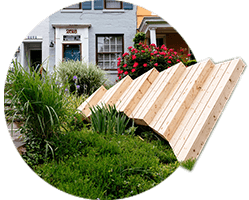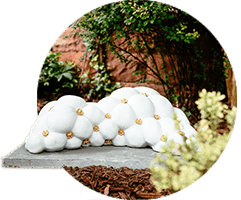- May 31, 2016
- By Lauren Brown
A giant steel pulley juts from a neatly groomed front lawn in the Foggy Bottom neighborhood of D.C.
Measuring 8 feet across and painted an antique-y rust, it’s frozen in motion, clunky but elegant, yet right at home, evoking the industrial 19th-century roots of the now-affluent hamlet.
The artwork, handcrafted by Dane Winkler M.F.A. ’16, is one of 13 contemporary sculptures, new media installations and performances featured in the Arts in Foggy Bottom Outdoor Sculpture Biennial show, which runs May 14–Oct. 22. The “Turf and Terrain” self-guided walking tour-exhibit was curated by UMD doctoral student Danielle O’Steen (right) and features four Terp artists. All created works that celebrate the community’s eclectic history, architecture and culture.
“The show brings up overlooked details and aspects of the neighborhood that people might not know,” she says.
Foggy Bottom, nestled in Northwest Washington, came to life during the Industrial Revolution, when breweries, glassworks and other factories opened along the Potomac River. The jobs attracted a wave of German and Irish immigrants who settled in the low-lying area, named for the fog that rose from the water.
Today, it’s a primarily residential and historic area of about 135 charming and stately buildings, mostly rowhouses built in the late 1800s and early 1900s.
Jackie Lemire, who co-founded Arts in Foggy Bottom a decade ago and now is one of its directors, says one of the exhibition’s major goals has always been to bring neighbors together, to pause at the sculptures and talk to each other.
Not only has that happened, she says, but homeowners have consistently volunteered to display the sculptures on their lawns; seven have even bought them. But those aren’t the exhibition’s only measure of success.
“We know it’s working when we meet people on the street, who say they love it or ask if it’s coming back. We get many requests for tours, we get great turnouts, and you see how quickly the brochures disappear,” she says.
The show, first held in 2008, features a new curator each time. O’Steen, who earned her master’s degree in art history from George Washington University in Foggy Bottom, had attended the past two shows.
At UMD, she studies art history, specializing in the history of sculpture in the 1960s and 1970s, and has curated three other exhibitions in the area. The nontraditional gallery space of this one—residents’ front yards—was part of its appeal.
“I’m interested in the most expanded notion of what sculpture can do,” she says. “I’m hoping that because the sculptures are in public space, we can push those limitations in a way we can’t in a gallery space.”

She began enlisting artists last fall, and of the four participating Terps, had previously worked only with Krista Caballero, assistant director of the Design: Cultures and Creativity program in the Honors College. The others, she says, weren’t so much of a coincidence as inevitable, given the strength of the University of Maryland’s art program.

Caballero is exhibiting “Birding the Future,” a collaboration she’s had with Norwegian artist Frank Ekeberg since 2013. The installation invites passersby to listen to the recorded birdcalls of endangered and extinct native species while using a stereoscope to view composite images of them on cards, all kept in a box on site. (The vivid recordings have attracted a riot of live chirping, too, from birds above and around the I Street block.)
Next door, Rob Hackett M.F.A. ’14 built “Step Right Up,” a curving wooden staircase standing almost on its side and traversing a front yard as an abstract monument to footpaths and walking.
Jonathan Monaghan M.F.A. ’11 is showing a marble lamb sculpture with golden decoration, seemingly sleeping in a shady garden. His “Agnus Dei (After Zurbarán),” was inspired by a 1635 painting by Francisco de Zurbarán, but Monaghan created the 3-D model digitally.
O’Steen was drawn to how the animal form emphasizes the natural landscape and setting of Foggy Bottom that’s often overlooked. Monaghan says he also likes the tension between the past and future:
He does most of his work in film animation, and this was his first time exhibiting a sculpture outside. “It’s something new and different,” he says. “I’m used to the nice, controlled space of the gallery. I didn’t think of bugs crawling on it or birds pooping.”

While a public outdoor exhibit can really start anywhere, Winkler’s “Round Top Dig” pulley on the highly visible corner of New Hampshire Avenue and I Street NW is the intended starting point.
Raised on a farm outside Albany, N.Y., he was fascinated by clanking, crunching old machinery. Today he works mostly in fabricated steel, deconstructed wood and new media. Researching Foggy Bottom, he couldn’t help but wonder: “What if you were to dig it up? I was thinking of what’s left behind.”
